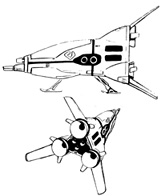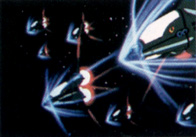 by Pieter Thomassen, with Peter Walker
by Pieter Thomassen, with Peter Walker
| | | | | |
Gnerl (model 1, model 2, model 3) Aerospace Fighter/Attack Plane
|

|

|
 |
 |  |  |  |  |  |
I. Dimensions:
All models:
| Length: | 17.4 m |
| Width: | 12.0 m |
| Height: | 12.0 m |
| Weight (full load): | 34 metric tons Models 1 and 2 |
| | 35.5 metric tons Model 3 |
II. Type:
All models:
- Design: Quanitszip design bureau.
- Builder: Numerous yards throughout the Tirolian Mercantile Empire.
- Type: One man aerospace fighter and attack plane.
III. Service History:
- Models 1 and 2 : Served with all arms of the Regular Zentraedi Forces and Border Fleets from 1891 (model 1) and 1899 (model 2) onwards, replacing the Soarove attack fighter.
- Model 3 : Served with the Zentraedi Garrison Forces and Border fleets from 1904 onwards (model 3), replacing the Soarovela fighter.
IV. Propulsion:
All models:
- Three Varrebotzs type 49 plasma-shock expansion engines in the back. The
thrusters have a maximum output of 190 kN for short periods and a sustainable
output of 120 kN.
- Three Varrebotzs type 50 plasma-shock expansion engines with vectorable
nozzles (drawing their plasma from the type 49 engines), mounted in the back
between the type 49 engines. These thrusters have a maximum output of 45 kN for
short periods, and serve both as attitude thrusters and as boost engines for
emergency accelerations.
- Four Varrebotzs type 51 aplasma-shock expansion engines (drawing their
plasma from the type 49 engines) in two pairs, one to port and one to starboard,
in the center of the flanks. These engines are the primary jaw and roll attitude
thrusters and have vectored thrust capabilities. Each thruster has a maximum
sustained output of 78 kN.
- Assorted attitude thrusters, fed from the type 49 engines.
- Fuel: 20 standard canisters of protoculture.
- Models 1 and 2:
One Varrebotzs type 54 plasma-shock expansion engine (drawing its plasma from the type 49 engines) under the cockpit. This engine is the primary VTOL thruster and has limited vectored thrust capabilities. This thruster can deliver 400 kN for less than a minute during take-off and landing, or about 100 kN sustained thrust.
- Model 3:
Four Varrebotzs type 57 plasma-shock expansion engines under the cockpit. These engines are the primary VTOL thrusters and have vectored thrust capabilities. This installation can deliver 150 kN sustained thrust per engine or 180 kN for short periods.
V. Performance:
- Maximum speed @ sea level: 1400 kph (in Earth-like atmosphere) (Model 3 slightly less)
- Maximum speed @ 40000 m: 5890 kph (in Earth-like atmosphere) (Model 3 slightly less)
- Stall speed @ sea level: 350 khp (in Earth-like atmosphere)
- Combat radius : total delta-v 4.7 kps
- Protoculture supply : average operational life 175 hours operational use.

VI. Sensory Systems: (All models)
Radar tracking:
- VFAS1-SS (*) phased array radar with spherical coverage, for various scan/track, targeting, mapping, reconnaissance and navigation functions.
Optical tracking:
- VFAS1-SS Multi-band digital camera system, for medium range all attitude infra-red imaging, optical and ultra-violet band detection and tracking.
- VFAS1-SS Multi-frequency laser ranger and designator.
- VFAS1-SS high resolution long range optical/IIR cluster in the nose, on top of the gun armament.
Tactical Electronic Warfare System (TEWS):
- VFAS1-SS Radar Warning Receiver (RWR)
- VFAS1-SS Infra-red Warning Receiver (IRWR)
- VFAS1-SS Active sensor jammer system
- VFAS1-SS Chaff and flare dispenser
(*) Terran designation. The Tirolian designers considered the sensors part of the design and did not assign separate designations for these systems.
VII. Armament:
Cannons:
Model 1:
- 3 x Makral Martszur-3 (also known under the Terran designation of PB-8) triple-barreled rotary particle beam cannons mounted in the extreme nose of the plane. The sub-barrels can each fire a particle beam of 2.5 MJ every second, all can be fired in parallel, for maximum localized damage, or in series for increased chances of a hit. Typically, Gnerl pilots fired in serial mode.
Models 2 and 3:
- 2 x Makral Martszur-4 (also known under the Terran designation of PB-8) triple-barreled rotary particle beam cannons mounted in the extreme nose of the plane. The sub-barrels can each fire a particle beam of 2.5 MJ every second, all can be fired in parallel, for maximum localized damage, or in series for increased chances of a hit. Typically, Gnerl pilots fired in serial mode.
- 1 x Makral Rianulran-23 (also known under the Terran designation of AD-1) particle pulse cannon mounted in the extreme nose with the Makral Martszur-4 cannons. This cannons fires distinct packages of particle energy ('annihilation discs') at 3500 m/s in bursts of up to 1 second in duration. A maximum duration burst contains 25 MJ of particle energy, and will usually impact in a concentrated area. The Makral Rianulran 23 cannon has a recharge cycle of 8 seconds, yielding a rate of fire of 7.5 rpm.
Missiles:
All Models
- 3 x Touwhaug Gativar-9 missile launchers, lying flush with the skin between the engines. Each missile launcher carries 2 Whernid Awhaug (codenamed Mitten by the RDF) missiles in a ready for launch position, and four more Whernid Awhaug missiles as reloads. The total load-out for the Gnerl mecha is 18 missiles.
Model 3 only:
- 1 x hardpoint on the upper wings for a Touwhaug Rasilszt-13 missile launcher. The missile launcher carries 5 Gerluj Touwhaug, Gluuk Awhaug or Vlwheralt Awhaug (codenamed Miff, Megrim or Morgoth by the RDF) missiles, or a combination of these. Due to excessive drag and limited utility this option was rarely used.
VIII. Armor:
All models:
The armor of the Gnerl is composed of an advanced titanium-steel alloy. The
armor stops all small arms and heavy infantry weapons fire, provides reasonable
resistance to light mecha-mounted weaponry, such as the Zentraedi 22.3mm HE
autocannon round, and poor resistance to medium mecha-mounted weaponry, such as
the Valkyrie's 55mm APFSDS round.
The Gnerl provides full protection from nuclear, biological, and chemical
hazards, using an fully enclosed cockpit environment. The internal consumables
supplies can provide atmosphere for four days maximum, and the pilot can pack
sufficient food and water containers for that period, although the cockpit will
be somewhat cramped.
IX. Development:
First deployed operationally in 1891, the Gnerl was the last trans-atmospheric fighter used by the Zentraedi. In the early teens of the 21st century, when the last Gnerl were produced, a successor design was only in the earliest planning stages.
The Gnerl were fast trans-atmospheric fighters with an egg-shaped nose housing a powerful cannon installation and three thrusters at the back. The hull also accommodated three double dual-purpose missile launchers nested between the engines. The shipborne fighters had landing skids and small VTOL thrusters, enough to let the mecha land on a planet if required. However the margin for error was small during these operations. The planetary model had a more extensive VTOL setup, enough to let the fighter make a safe landing even if two of the thrusters were not operational. The redundancy was necessary because they relied on body lift and thus had no wings as such, which made for high stalling velocities and extensive use of the VTOL thrusters.
Three models of the Gnerl were built, of which the first two were identical in all but the cannon armament. The first model carried three identical particle beam cannons, the second model carried two of these cannons plus a burst-fire pulsed particle cannon. The latter version was intended as a ship/ground attack variant, and therefore carried a weapon (the pulsed particle beam) that could hand out larger amounts of damage in a small area in a shorter time than the other model could. This came at the price of a somewhat less effective air-to-air cannon armament.
These two models were carried on board Zentraedi warships and as such had simple landing skids and a limited VTOL installation, relying instead on equipment in the ships themselves to position themselves for launch. The third model had wheels rather than skids and a more robust VTOL system, and was intended to operate from groundside airfields. It had the cannon armament of the attack model, and two (seldom used) hardpoints for ten more medium missiles.
Compared to contemporary 2010 Terran designs (mainly the VF-1 Valkyrie) the Gnerl were faster, had a better thrust/weight ratio, and carried a far more lethal cannon armament (especially in space). The maneuverability in an atmosphere was acceptable, and was considered satisfactory in space. The missile armament was larger in numbers than that of the standard Valkyrie, but even though several Whernid Awhaug missile variants existed, not nearly as varied and capable as the external loads that could be carried by the Terran mecha. Hence, the shipborne Gnerl is perhaps best characterized as an interceptor with secondary attack capabilities, and the third model as a mediocre attack fighter, while the Terran mecha were more true swing-role designs.
See additional design notes.
Return to Zentraedi Aircraft Index.
Go to Robotech Reference Guide Home Page.
Robotech (R) is the property of Harmony Gold. This document is in no way intended to infringe upon their rights.
Content by Pieter Thomassen, with Peter Walker and Rob Morgenstern
HTML by Robert Morgenstern (rmorgens@ieee.org)
Copyright (c) 2003, 2000, 1997, 1995 Robert Morgenstern, Pieter Thomassen, Peter Walker



